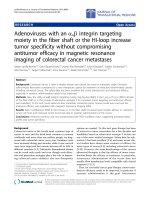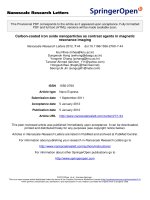Common Mistakes and Pitfalls in Magnetic Resonance Imaging of the ACL
Bạn đang xem bản rút gọn của tài liệu. Xem và tải ngay bản đầy đủ của tài liệu tại đây (11.89 MB, 31 trang )
Common Mistakes and Pitfalls in
Magnetic Resonance Imaging of the ACL
BS CK II MÃ NGUYỄN MINH TÙNG
PKĐK HÒA HẢO- (MEDIC- HCM)
Partial versus complete anterior cruciate
ligament tears
MRI evaluation of a partial anterior cruciate ligament (ACL) tear and
differentiation from a complete ACL tear, mucoid degeneration or even
a normal ACL can be challenging because of overlapping imaging
features
MRI has an overall moderate accuracy to distinguish stable from
unstable ACL tears. ACL discontinuity and abnormal orientation of ACL
fibers have an accuracy of 79% and 87% respectively.
Although anterior tibial translation, uncovering of the posterior horn of
the lateral meniscus, and hyperbuckled PCL are specific signs of an
unstable tear, the sensitivity of these signs is as low as 23%.
Bone marrow edema around the lateral knee compartment is not a good
paraeter for predicting stability
ACL, MRI ANANTOMY
Two fiber bundles of ACL. The anteromedial bundle (AMB) forms the anterior portion of the ACL,
while the posterolateral bundle (PLB) forms the posterior portion. Overall, ACL is subject to the maximum tension at the maximum extension and 90-degree flexion, and the tension mainly acts
on the AMB, resulting in frequent injury of AMB
Tibial attachment site of the ACL. (a) Cadaveric knee and (b) PDWI of a human subject. ACL
attaches to the tibia at the site spreading like a fan between the tibial spine and the anterior horn
of the medial meniscus (arrows).
In sagittal images, the anterior border of the ACL is smooth and shows hypointensity in all
sequences. This corresponds to the fibers of AMB. The middle and posterior portion of the ACL
may show mild hyperintensity due to some fat tissue that is present within the ACL fibers, which
is less dense at these locations compared to the anterior portion.
Complete Tear of ACL
Complete tear of all fibers of the ACL.
Approximately 70% occurs at the central portion of the ACL.
Approximately 20% occurs at the femoral attachment site
Partial Tear of ACL
Partial tear of ACL occurs if only AMB or PMB, either entirely or partially, is torn. However, it
is difficult differentiate these two bundles on MRI, and clinically all tears that are not
complete are classified as partial tear.
Diagnosing partial tear of ACL on MRI is said to be very difficult.
AMB is more commonly affected than the PMB.
MRI findings
Primary sign
Fibers may appear continuous.
Fine intrasubstance hyperintensity within the ACL or angulation of the ligament may be
seen.
Immediately following an acute injury, edema, hemorrhage, and synovial thickening may
hinder the imaging diagnosis, making it difficult to differentiate between partial and
complete tear.
angulation of the ligament may
be seen.
If more than 50% of the ACL fibres are torn this would be considered a high grade tear, a medium
grade tear is 10%-50% of fibres torn, while a low grade tear is less than 10% of fibres torn.
The Holy Grail, with respect to imaging of partial ACL tears, would be to have sufficient resolution
to determine whether there was a low, medium or high grade tear in each particular ACL bundle.
Wing Hung Alex Ng, MBchB, FRCR,
Department of Imaging and Interventional Radiology, Prince of Wales Hospital, Chinese University of Hong Kong, Hong Kong,
MRI findings
Secondary signs
Although anterior tibial translation, uncovering of the posterior horn of the
lateral meniscus, and hyperbuckled PCL are specific signs of an
unstable tear, the sensitivity of these signs is as low as 23%.
Bone marrow edema around the lateral knee compartment is not a good
paraeter for predicting stability
Anterior tibial translation between 5 and 7 mm is suggestive and over 7 mm is diagnostic of
anterior cruciate ligament tear.
Sagittal T2- weighted fat suppression magnetic resonance knee image shows that there are
bone rises present in the mid-lateral femoral condyle and posterolateral tibial plateau which
indicate that the mechanism of injury is internal rotation of the tibia in valgus stress injury. This
pattern of bone bruise has a high association of anterior cruciate ligament complete tear
Patellar buckling sign and lateral femoral notch sign.
Normal condylopatellar sulcus should be smaller than 1.5 mm.Notch depth between 1 and 2
mm is suggestive and over 2 mm is diagnostic of anterior cruciate ligament tear.
Buckling of proximal patellar tendon (white arrow) also indicates the underlying anterior cruciate
ligament tear.
Pitfalls in Magnetic Resonance Imaging
of the ACL









